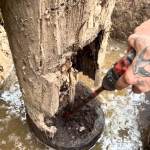- Severely deteriorated wood pilings, particularly at locations labeled “C” and “B” on the structural plan.
- The need for temporary shoring to facilitate beam removal and replacement.
- Potential deflection and collateral interior damage due to structural adjustments.
- Ensuring a stable, long-term support solution while maintaining the integrity of the historical building.
Our team recommended and installed Concentric Push Piers (PPB-250s, 2-7/8” diameter steel pipe) as a temporary stabilization measure. These piers provided robust load-bearing capacity (~52,000 lbs per bracket) to support the structure during the removal and replacement of the compromised beams. The approach included:
- Installing a temporary parallel beam offset from the existing perimeter beam.
- Utilizing concentric brackets and push piers spaced 4’-6’ on center to provide essential support.
- Driving steel pipe pilings deep into the soil for structural stability.
- Evaluating the need for additional push piers in lieu of concrete piling caps, given the severe wood deterioration.
- Coordinating closely with the deck contractor for seamless beam replacement execution.

Concentric Push Bracket
- The push pier system successfully stabilized the structure, enabling safe beam removal.
- Alternative solutions were proposed for long-term reinforcement, considering the unsuitable condition of the existing pilings for concrete caps.
- Minimal impact on surrounding structures, with the understanding that slight deflection in floor joists was necessary for stabilization.
- A cost-effective approach, with the project estimate remaining within $50,000, barring unforeseen site conditions.
The implementation of Concentric Push Piers provided an effective temporary stabilization solution for Raymond Manor, allowing for safe and efficient structural repairs. This case highlights the importance of adaptive foundation repair strategies in historical building preservation. Future considerations include the potential for permanent push pier installations to replace failing wood pilings, ensuring long-term structural integrity.






